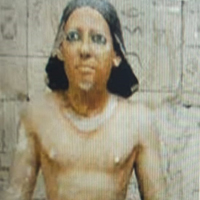Ahmes
Ahmes was an ancient Egyptian scribe who lived towards the end of the Fifteenth Dynasty and the beginning of the Eighteenth Dynasty, He wrote the Rhind Papyrus – one of the oldest known mathematical documents.
Ahmes is the scribe who wrote the Rhind Papyrus (named after the Scottish Egyptologist Alexander Henry Rhind who went to Thebes for health reasons, became interested in excavating and purchased the papyrus in Egypt in 1858).
A secretary rather than author, as he himself stated in the manuscript, Ahmes indicated that he was recording mathematical information from an earlier work, one dated to perhaps 2000 b.c. The Rhind Papyrus contains 87 problems in basic arithmetic, and illustrates simple fractions.
By 3000 BC the Egyptians had already developed their hieroglyphic writing (see our article Egyptian numerals for some more details). This marks the beginning of the Old Kingdom period during which the pyramids were built. For example the Great Pyramid at Giza was built around 2650 BC and it is a remarkable feat of engineering. This provides the clearest of indications that the society of that period had reached a high level of achievement.
The earliest known unambiguous examples of written records—dating from Egypt and Mesopotamia about 3100 BCE—demonstrate that ancient peoples had already begun to devise mathematical rules and techniques useful for surveying land areas, constructing buildings, and measuring storage containers. In Babylonian clay tablets (c. 1700–1500 BCE) modern historians have discovered problems whose solutions indicate that the Pythagorean theorem and some special triads were known more than a thousand years before Euclid. A Babylonian cuneiform tablet written some 3,500 years ago treats problems about dams, wells, water clocks, and excavations. It also has an exercise on circular enclosures with an implied value of π = 3. The contractor for King Solomon’s swimming pool, who made a pond 10 cubits across and 30 cubits around (1 Kings 7:23), used the same value. However, the Hebrews should have taken their π from the Egyptians before crossing the Red Sea, for the Rhind papyrus (c. 2000 BCE; our principal source for ancient Egyptian mathematics) implies π = 3.1605.
The papyrus is our chief source of information on Egyptian mathematics. The Recto contains division of 2 by the odd numbers 3 to 101 in unit fractions and the numbers 1 to 9 by 10. The Verso has 87 problems on the four operations, solution of equations, progressions, volumes of granaries, the two-thirds rule etc.
The Rhind Papyrus, which came to the British Museum in 1863, is sometimes called the ‘Ahmes papyrus’ in honour of Ahmes. Nothing is known of Ahmes other than his own comments in the papyrus.
The Rhind papyrus
It is a collection of exercises, substantially rhetorical in form, designed primarily for students of mathematics. Included are exercises in
fractions
notation
arithmetic
algebra
geometry
mensuration
The practical mathematical tools for construction.He’s also the first mathematician to use fractions. He could calculate their volumes, and, as appears from his taking the Egyptian seked, the horizontal distance associated with a vertical rise of one cubit, as the defining quantity for the pyramid’s slope, he knew something about similar triangles.
The Rhind Mathematical Papyrus is one of the best known examples of ancient Egyptian mathematics. It was apparently found during illegal excavations in or near the Ramesseum. It dates to around 1550 BC. The British Museum, where the majority of the papyrus is now kept, acquired it in 1865 along with the Egyptian Mathematical Leather Roll, also owned by Henry Rhind. The Rhind Mathematical Papyrus dates to the Second Intermediate Period of Egypt. It was copied by the scribe Ahmes from a now-lost text from the reign of king Amenemhat III. Written in the hieratic script, this Egyptian manuscript is 33 cm tall and consists of multiple parts which in total make it over 5 m long. The papyrus began to be transliterated and mathematically translated in the late 19th century. The mathematical translation aspect remains incomplete in several respects. The document is dated to Year 33 of the Hyksos king Apophis and also contains a separate later historical note on its verso likely dating from the period of his successor, Khamudi.
In the opening paragraphs of the papyrus, Ahmes presents the papyrus as giving “Accurate reckoning for inquiring into things, and the knowledge of all things, mysteries … all secrets”.
Several books and articles about the Rhind Mathematical Papyrus have been published, and a handful of these stand out. The Rhind Papyrus was published in 1923 by Peet and contains a discussion of the text that followed Griffith’s Book I, II and III outline. Chace published a compendium in 1927–29 which included photographs of the text. A more recent overview of the Rhind Papyrus was published in 1987 by Robins and Shute.

Ahmes
Date of Birth: 13 Nov 2025
Birth Place: about 1680 BC,Egypt
Proffession: Egyptian scribe
Nationality: Egyptian
Death: about 1620 BC,Egypt


